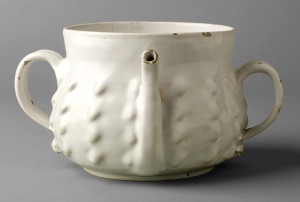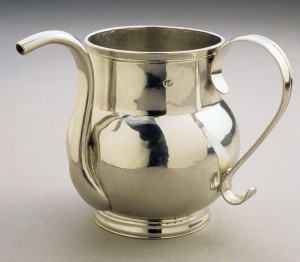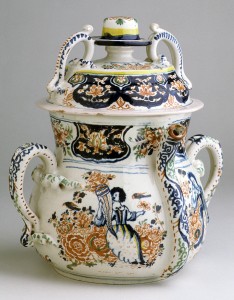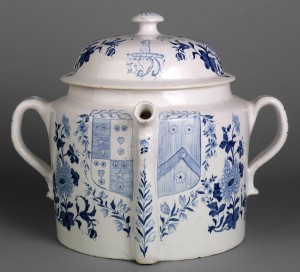The word posset initially referred to certain medicinal drinks, and recipes for the concoction are known from as early as the mid-1400s. By the early 1600s in England, the drink was served socially in specialized, spouted vessels and typically featured warmed wine, milk, and spices. The milk curdled and rose to the top, and the spiced wine was drunk from the straw-like spout on the side of the pot. The curds were eaten separately with a spoon. The taste for posset in England and America fell out of favor by the late 1700s.
A Receipt for all young Ladies that are going to be Married. To Make a SACK-POSSET.
From famed Barbados on the Western Main
 Fetch sugar half a pound; fetch sack from Spain
Fetch sugar half a pound; fetch sack from Spain
A pint; and from the Eastern Indian Coast
Nutmeg, the glory of our Northern toast.
O’er flaming coals together let them heat
Till the all-conquering sack dissolves the sweet.
O’er such another fire set eggs, twice ten,
New born from crowing cock and speckled hen;
Stir them with steady hand, and conscience pricking
To see the untimely fate of twenty chicken.
From shining shelf take down your brazen skillet,
A quart of milk from gentle cow will fill it.
When boiled and cooked, put milk and sack to egg,
Unite them firmly like the triple League.
Then covered close, together let them dwell
Till Miss twice sings: You must not kiss and tell.
Each lad and lass snatch up their murdering spoon,
And fall on fiercely like a starved dragoon. New York Gazette, February 13, 1744
 Posset pot
Posset pot
Probably Southwark, London, England; 1650–60
Earthenware (delftware)
Bequest of Henry Francis du Pont 1959.1898
This posset pot now lacks its original lid. The “bosses” (raised ornament) were created by the potter pushing outward with his fingers. Bossed delftware was made at Pickelherring and other London factories and rare examples survive with dates from the 1650s.
 Spout cup
Spout cup
John Edwards
Boston, Massachusetts; about 1700 (covered cup)
Silver
Inscribed “SM”
Gift of Henry Francis du Pont 1965.1358
Spout cup
John Dixwell
Boston, Massachusetts; 1700–1725
Silver
 Inscribed “NCS”
Inscribed “NCS”
Gift of Henry Francis du Pont 1965.1357
Spout cups, like these rare American examples, typically had lids. The “SM” initials on the covered cup may refer to Sarah Marshall, who married John Marshall of Boston in 1699. On the same cup, “MC” may refer to the Marshalls’ descendant Mary Thaxter Cushing. On the lidless cup, “NCS” is thought to identify Noah and Sarah Champney, who were married in Boston by Cotton Mather on August 14, 1701.
Posset pot
London or Bristol, England, or Delft, The Netherlands; dated 1709
Earthenware (delftware)
Inscribed “SP / 1709”
Bequest of Henry Francis du Pont 1959.1894a,b
 Posset pots
Posset pots
Probably Bristol, England; 1700–1715 (left)
Probably London, England; dated 1711 (right)
Earthenware (delftware)
Inscribed “RDA /1711”
Bequest of Henry Francis du Pont 1958.2381, 1959.1875
The painted ornament on these two pots was inspired by designs on Chinese export porcelain of the late 1600s. Now lacking its lid, the blue and white pot bears the initials of the original owners.
Posset pot with arms of Hamilton of Udstown and Hamilton of Bardowie
Delftfield Pottery
Glasgow, Scotland; 1749–75
Earthenware (delftware)
Bequest of Henry Francis du Pont 1957.536
Lawrence Dinwiddie and his brother Robert, the future royal governor of Virginia, were part owners of the factory that produced this unusually large and important Scottish vessel. Lawrence negotiated with Bonnie Prince Charlie when he was driven back to Scotland by the English forces. In 1749 the Delftfield factory’s first advertisement appeared in the Glasgow Courant and announced that services bearing “Coats of Arms painted upon them” could be ordered by noblemen and gentlemen. The arms on this posset pot commemorate two families who lived near Glasgow.
Related Themes:



